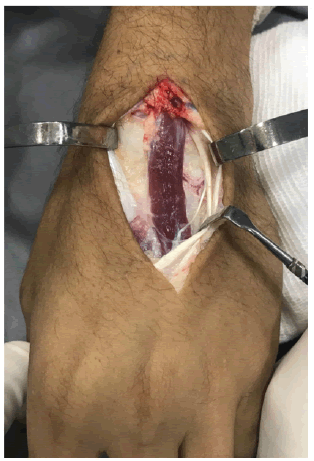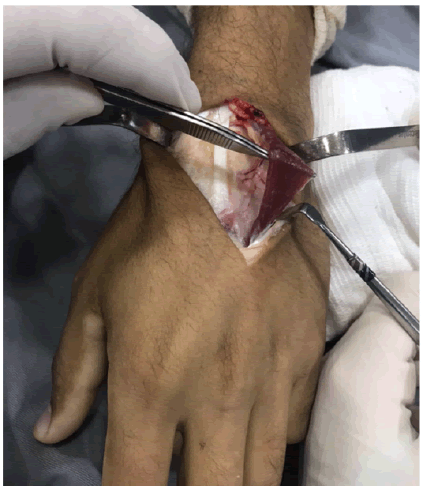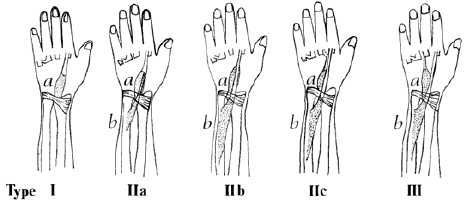Extensor Digitorum Brevis Manus: A Case Report
1 Department of Plastic Surgeon, Hand Surgery Service, Lifecenter Hospital, Brazil
Received: 08-Apr-2022, Manuscript No. AMHSR-22-59371; Editor assigned: 11-Apr-2022, Pre QC No. AMHSR-22-59371(PQ); Accepted Date: May 05, 2022 ; Reviewed: 26-Apr-2022 QC No. AMHSR-22-59371; Revised: 29-Apr-2022, Manuscript No. AMHSR-22-59371(R); Published: 05-May-2022, DOI: 10.54608.annalsmedical.2022.36
Citation: Filho ATF, et al. Extensor Digitorum Brevis Manus: A Case Report. Ann Med Health Sci Res. 2022;12:125-127.
This open-access article is distributed under the terms of the Creative Commons Attribution Non-Commercial License (CC BY-NC) (http://creativecommons.org/licenses/by-nc/4.0/), which permits reuse, distribution and reproduction of the article, provided that the original work is properly cited and the reuse is restricted to noncommercial purposes. For commercial reuse, contact reprints@pulsus.com
Abstract
The extensor digitorum brevis manus is a variant muscle located in the dorsum of the hand in the fourth compartment. Because of the mass effect, it can cause pain during hand function. This article consists in a presentation of surgical findings of an extensor digitorum brevis manus during a ligament reconstruction of wrist and a literature review of this rare hand variation.
Keywords
Anatomical variation; Extensor digitorum brevis manus
Introduction
The Extensor Digitorum Brevis Manus (EDBM) is a variant muscle located in the dorsum of the hand in the fourth compartment, associated with pain of the index and long fingers during manual labor. Literature reports show that the EDBM often goes underdiagnosed and is frequently discovered incidentally in the operating room or in cadaveric dissections. It originates from the dorsal aspect of hand and wrist, and is innervated by the posterior interosseous nerve. It measures six to nine centimeters and its function is to extends and maybe deviates the finger to the side on which the EDBM is inserted. We present surgical findings in which symptoms were probably not associated to its presence. [1-3]
Case Report
Patient was a 27-year-old male metalworker and engineering student who was taken to surgery for reconstruction of scapholunate ligament, previously operated on the opposite hand, with no anomaly noticed [Figure 1]. When the muscle belly was retracted individually it extended the index finger [Figure 2].
Disussion
The name extensor digitorum brevis manus was introduced by Macalisterin 1866, but first noticed by Albinus in 1734, using the term musculus extensor brevis digiti indicis velmedii. [2,3]
EDBM is a rare anatomical variant that is usually found during procedures involving the fourth extensor compartment. Gama reported an incidence of 1.1% in 3404 adults between the ages of 23 and 56 years randomly examined between 1975 and 1981. [1]
Ranade e cols reported an incidence of 2%-3% of the population, with slight male predominance of the EDBM, a muscle supposed to extend the index finger. [3] In their review, Tan and smith reported that one third of patients with EDBM had it bilaterally, with no difference in incidence between the right and left hands. [2]
Although generally asymptomatic, the patient may present with a painful dorsal wrist mass, particularly manifested in individuals performing repetitive movements of the wrist and hand. [3,4] The presence of these additional muscles in the fourth compartment of the extensor retinaculum, may lead to a condition called “fourth-compartment syndrome,” which is manifested by chronic dorsal wrist pain. The increased pressure within this compartment may compress the posterior interosseous nerve directly or indirectly. During physical examination, the EDBM can be confused with inflammatory or tumoral conditions, therefore the importance of excluding these differential diagnostics. [4]
In a detailed study of 559 cadaver dissections in Japan, Ogura et al. found the EDBM to arise from the posterior radiocarpal ligament, close to the lunate and frequently as far proximal as the distal margin of the radius, but without direct connection or attachments to the carpal bones. This suggests that the EDBM originates from an extrinsic muscle, and its insertion is similar to that of the Extensor Indicis Pollicis (EIP). [5]
Ogura et al. also classified the anatomy of the EDBM has been classified into three types, according to its insertion and relationship with EIP [Figure 3]. In type I, the EPI is absent and the EDBM inserts as would the EIP. In type II, both of them insert on the index finger. This type was further divided into three subtypes: in the type IIa, the vestigial EIP arises from the ulna, but its belly is confluent with the EDBM's, which inserts on the index finger. In type IIb, the distal part of the EDBM belly joints with the EIP tendon. Finally, in type IIc, EIP inserts normally, but a thin EDBM tendon also inserts more ulnarly than EIP tendon. In type III, the EIP also inserts normally on the index finger and the EDBM inserts on the middle finger with or without an accessory EIP to the middle finger. According to this, yours surgical finding is Ogura’s type III. [5]
Reviews suggest that the EDBM inserts more commonly on the index finger (types I and II) than onto the middle finger (type III), according to the majority of publications. On the other hand, when the EIP was absent as in type I, the EDBM had the highest frequency when compared to subtypes II and type III where the EIP was present. It is accepted that this finding would favor the theory of EDBM as an extensor substitute in the case of EIP agenesis. [5]
However describes anatomical findings, the Ogura et al. classification has not shown any functional relevance and do not predicts treatment. [5-7] The treatment depends on the severity of symptoms. Conservative treatments, such as short wave diathermy, paraffin baths or immobilization and anti-inflammatory drugs can be used. But they have been unsuccessful when the symptoms are severe. Surgical treatment of this anomaly should be limited to those with significant symptoms, or even using the EDBM as a tendon transfer. [2]
In this case report, we described a very rare anatomic finding that was classified as type III of Ogura, as the EDBM was inserted on the middle finger. Symptoms were mostly justified by ascapholunate ligament instability but, as shown previously, it could also be explained by the presence of an anatomical variation in the fourth compartment. We decided not to reset the EDBM but decompress it and observe the resolution of symptoms. Since then, the patient has improved function of the hand as a metal worker with no limiting pain.
Conclusion
The knowledge of anatomical variant muscles may be important when one is assessing the traumatized or diseased hand for differential diagnosis, and even reduce the number of repeat trips to the operating room. Therefore, as we faced a rare anomaly during a trauma procedure, the awareness of its prevalence would be an added value for hand surgeons in their surgical planning. This article presents surgeons with the possibility of the existence of extensor digitorum brevis manus as a cause of symptoms in the hand or as an occasional finding during surgical procedures, in addition to its review of the literature, in order to enhance diagnoses and treatments of the hand.
References
- Gama C. Extensor digitorum brevis manus: A report on 38 cases and a review of the literature. J Hand Surg. 1983;8:578-82.
[Crossref], [Google Scholar], [Indexed]
- Tans S, Smith P. Anomalous extensor muscles of the hand: A review. J Hand Surg Am. 1999;24:449-55.
[Crossref], [Google Scholar], [Indexed]
- Hart J. Extensor digitorum brevis manus. The Hand. 1972;4:265-267.
[Crossref], [Google Scholar]
- Ranade AV. Incidence of extensor digitorum brevis manus muscle. HAND. 2008;3:320-323.
[Crossref], [Google Scholar], [Indexed]
- Ogura T, Inoue H, Tanabe G. Anatomic and clinical studies of the extensor digitorum brevis manus. J Hand Surg Am. 1987;12:100-7.
[Crossref], [Google Scholar], [Indexed]
- Shereen R , Loukas M, Tubbs RS. Extensor digitorum brevis manus: A comprehensive review of this variant muscle of the dorsal. Cureus.2017;9:e1568.
[Crossref], [Google Scholar], [Indexed]
- Yammine k, The prevalence of extensor digitorum brevis manus and its variants in humans: A systematic review and meta‑analysis. Surg Radiol Anat. 2015;37:3-9.
[Crossref], [Google Scholar], [Indexed]







 The Annals of Medical and Health Sciences Research is a monthly multidisciplinary medical journal.
The Annals of Medical and Health Sciences Research is a monthly multidisciplinary medical journal.